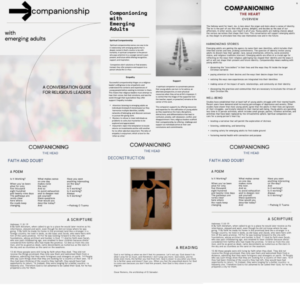“Part of me wishes I had left the whole thing alone, and that I could just go back to the exact same complex arrangement of blocks I had before without questioning how or why they fit together. The other part of me realizes that’s impossible…Whew. I think that’s the first time I’ve really worked that out in words.”
This e-mail is not an anomaly; I receive these kinds of messages frequently—especially over e-mail or text. One’s heart is laid bare through keystrokes, sent through waves, and lands in my inbox. Should we really talk about this over wi-fi?
Since the pandemic, the arguments about the faithfulness of digital ministry have largely ceased. The question is, “how do we do this thing well?”
If this is our question, then I offer a sub-question: how do we use technology to be in relationship with emerging adults, those members of the Body of Christ that played with iPads as babies and don’t know a world without streaming media?
Who are Emerging Adults?
Jeffrey Arnett coined the category “emerging adulthood” to refer to those individuals 18-25 (or 29) in industrialized nations that are on the journey from adolescence into adulthood.[1] Young people are growing up slower, caught in-between teen and adult, as they gradually accept more responsibility, financial independence, and autonomy apart from their primary caregivers.
In this new phase of emerging adulthood, ‘the twenties’ have become a crucial and fertile time for young persons to develop by paying attention to their hearts, their heads, and their hands.
 Companionship names one way to be in an empathetic and supporting relationship with emerging adults. Emerging adults consistently report that presence, or being seen, and listening, or being heard, are the most valuable resources during times of uncertainty and instability.
Companionship names one way to be in an empathetic and supporting relationship with emerging adults. Emerging adults consistently report that presence, or being seen, and listening, or being heard, are the most valuable resources during times of uncertainty and instability.
The Heart
The Hebrew word for heart, lev, is less about the organ and more about a sense of identity. The lev is the part of you that wills, grieves, delights, and decides as the seat of our affections. In other words, it’s all of us. Emerging adults are wrestling with their heart, which means they are making choices about identity, experiences, and desires. In time, the emerging adult will learn how to become attentive to her own life and identity, developing her own wholeness.
The Head
As emerging adults grow, they often reconsider theological beliefs as they accumulate life experiences. Many emerging adults are questioning the inherited beliefs they received from their own authority structures such as parents, churches, and other cultural influences. The fracture of their beliefs, and the corresponding freedom to develop new ones, can be overwhelming as emerging adults stitch together fragmented beliefs to create new theologies.

The Hands
The hands refer to the ways that emerging adults make sense of their place in the world as citizens and Christians. The Christian tradition has a rich sense of “vocatio,” or ways that we are called by God to inhabit the world with purpose. Here, the emerging adult receives permission to develop and articulate a dream that brings life, aligns with one’s values, and contributes to the kingdom of God or the common good.
In other words, young persons are deciding how and who to be, where and to what to belong, how and where to work and use their own giftedness in the world.
Digital Companionship
Digital communication is ubiquitous for emerging adults—and it’s real. Emerging adults are sending over 100 text messages a day to their friends and family members. Healthcare professionals are offering digital check-ups with young patients. Counselors are texting with their clients. And yet, the church has been slow to create strategies for digital relationship building and pastoral care. By entering the spaces inhabited by emerging adults, the church will communicate that these persons are worthy of risky, boundary-crossing ventures.
Here are three uses of digital technology with our emerging adults:
First: a faithful use of technology will help followers of Christ connect on personal levels—especially to the local and particular. The writer of John’s letters tells his friends that he would love to be with them in person, but he can’t. Instead, he sends a letter as a second-best option (2 John 12). Their physical relationship was not replaced by the technology. Instead, it was deepened.
- Pastors can unlock their phones and send a message like this: “I wish I could be with you today, but I can’t. Have you thought much about the most powerful image of God in your life right now? Just something to think about.”
Second: social media is an additional touchpoint to someone’s life and an opportunity to pay attention to another’s experiences, thoughts, and questions. Moreover, social media bestows invaluable insights that might reveal the ways that emerging adults are shaping their identities, locating their purpose, and finding groups of belonging.
- Religious leaders would do well to pay attention to the social media accounts that their young companions follow. Who do they retweet and share? What does the shared poem say about their recent experiences and overall state of well-being?
Third: Technology can also be used to bolster contemplative practices that result in love of God. Too often churches use social media only for marketing—quick images, quotes, sermon snippets that can be quickly consumed. The result is shallow, anonymous engagement. We’ve become another marketing gimmick for individuals to scroll past.
- There are ways that the church can subvert incessant, consumerist scrolling by providing an opportunity for real self-reflection and contemplation particularly through individual connection. Can we text, DM, or e-mail or young adults with images, stories, and reflections that require deep attention?
It’s a way to be involved in all aspects of their lives
I am still trying to heal. I am mourning someone I used to be but also desperately just wishing I could be her again, before I had the nerve (lol) to ask questions or critique beliefs. That was really hard to sit with as a truth. I’m still sitting with it.
And this feels like the right space to invite that hurt to the table and unpack it.
Here’s the point: Emerging adults are looking for spaces to work out the most important questions of their lives—questions of identity, purpose, belonging, and religiousness and spirituality.
Moreover, most of them lack the spaces with the trusted adults who will listen to them in empathy and support. Companionship, or developing individual relationships with emerging adults, isn’t a suggestion. It’s an imperative. And we can’t lay the burden on the young adults to find us. They won’t. There are too many institutional barriers.
Oftentimes, churches will ask, “where are the young adults?” I know one place many of them hang out.
It’s online.
a free resource:
Companionship Handbook: Themes, Conversation Starters, and Questions with Emerging Adults
[1] Jeffrey Jensen Arnett. Emerging Adulthood: The Winding Road from the Late Teens through the Twenties, 2nd ed. (n.p. Oxford University Press, 2014), 3.

 click here
click here